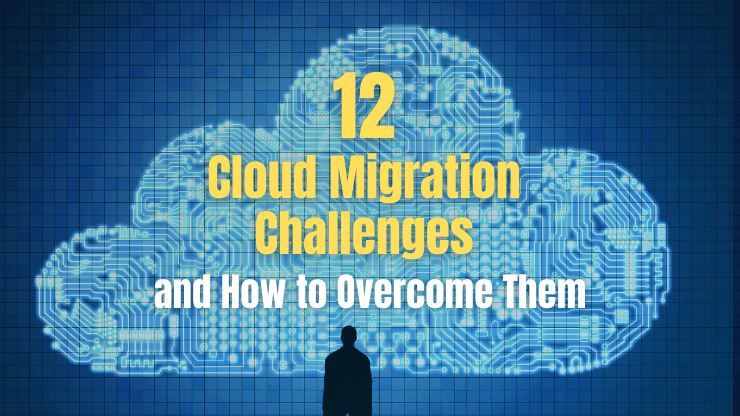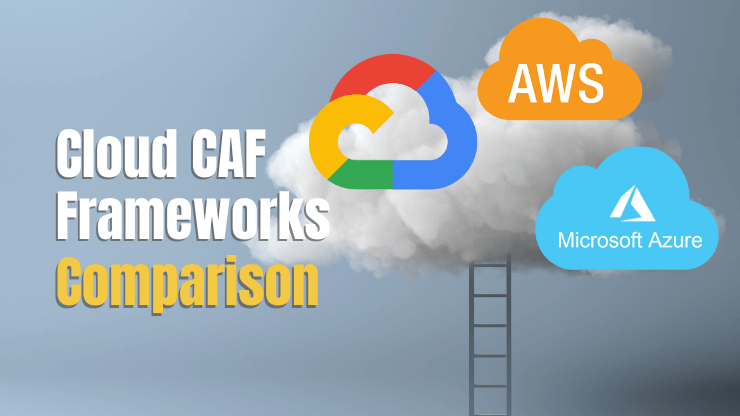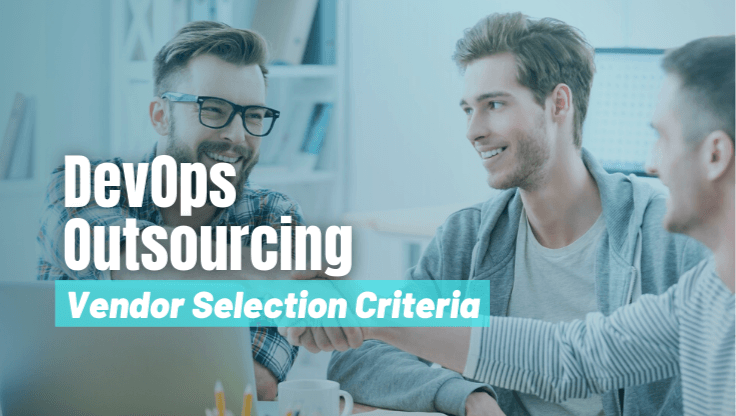Cloud computing is one of the largest digital transformations in recent years. The Global Cloud Computing Market size is expected to grow from 272 billion USD in 2018 to 623 billion USD by 2023, at a Compound Annual Growth Rate (CAGR) of 18% during the forecast period.
Even with such rapid growth, many businesses have yet to realize the full potential of a cloud because migration remains a significant challenge. Uncertainty about cloud costs, data security, and internal resistance to change are all major concerns.
At SoftKraft we help startups and SMEs unlock the full potential of managed cloud solutions. We plan, deliver and manage every step of your cloud migration journey with cloud migration consulting. Optimize cloud costs, improve data processing efficiency and strengthen security.
In this article, you will learn how to overcome top cloud migration challenges that most organizations also face when transitioning to a cloud environment.
- Overcoming Cloud Migration Challenges
- 1. Cloud environment adoption resistance
- 2. Uncertain cost of the cloud migration process
- 3. Skills gap: Hire cloud talent vs. upskill on-prem engineers.
- 5. Not having a solid cloud migration plan
- 6. Avoiding vendor lock-in within cloud migration strategy
- 7. Dealing with hybrid networking setups
- 8. Data Security and Compliance Risks
- 9. DevOps transformation on top of cloud migration
- 10. Building cloud SRE organization
- 11. Adopting cloud-native and 12-factor application architecture
- 12. Platform engineering architecture
- Conclusion
Overcoming Cloud Migration Challenges
Here are cloud migration challenges organizations face and possible solutions.
Cloud environment adoption resistance
When it comes to common cloud migration challenges, it is often people who pose the biggest challenge. People tend to resist change and a cloud migration brings a lot of change and disruption - often with significantly new systems, processes, and even leadership.
Failure to take care of the human aspects of migrating to the cloud will only cause you to struggle to execute a successful cloud journey.
Solution
A change management plan coupled with some key strategies can help you secure buy-in across the board and streamline the cloud adoption process.
If you want to drive successful adoption at the bottom, you have to start at the top. Your C-level leadership and other top leaders in the organizations play a significant role in driving cloud adoption and employee engagement. Thus, so you need strong executive buy-in right from the start.
Ensure the leadership understands the business requirements, as well as the objectives for going cloud. Get them to communicate the business case to the organization. When your employees understand why a change is being implemented, they are more likely to support it.
Furthermore, when choosing cloud solutions for your applications, prioritize integration and usability. Having a tool that is easy to use and understand will increase the likelihood that your employees will use it (and stick with it).
On top of that, applications that can work with your current tech stack are more attractive to users as they can easily seamlessly interpolate the new tools with their workflows. Integrations further streamline their work, improve efficiency. Remember to communicate those benefits before announcing changes.
Uncertain cost of the cloud migration process
Over time, cloud migration can reduce costs through improved productivity, reduced administrative expenses, and streamlined workflows. Nevertheless, achieving this can look complex and expensive.
Moving to the cloud can be a costly endeavor, especially when your company fails to estimate the financial impact beforehand. The migration expenses remain one of the significant issues business leaders face due to the cost of data migrations, compatibility issues, new skills demand, lack of data recovery plan, and even a wrong migration strategy.
Solution
The best way to avoid the unnecessary large cost of cloud migration is to prepare. Work with your cloud service provider to set out expenses related to the migration before you commit to a migration plan.
The planned cost of cloud migration should include the cloud platforms infrastructure costs, migration costs, financial risks from slow adoption, as well as the essential training required post-migration.
If not adequately planned, the budget necessary to cover all these alone is a challenge to moving to the cloud.
Our cloud migration consultant can help you with predicting the overall costs and to lower your cloud TCO.

Skills gap: Hire cloud talent vs. upskill on-prem engineers.
Cloud migration can scare a lot of your staff. People are scared they are going to be replaced. Cloud migration demands upgrading skills for the existing teams, especially when the business still runs on a legacy system. Lack of skill is a critical cloud migration challenge, and many organizations spend significant money on training their people.
Solution
You will need to both hire someone to help with the migration process and also upskill your existing team. You have to help them understand the impact of cloud designing and architecting like provisioning, cloud deployments, and auto-scaling.
You need engineers who know how your applications function; who will come up to speed on the cloud, and you also require cloud migration consultant from outside who possess the skills and know-how on migrating to the cloud. You need everyone to collaborate and figure out a cloud strategy and how you intend refactoring as you transition to cloud technology.
Get proactive with your education and awareness program. Set up cloud institutes, reward individuals for getting certifications, and make the whole process exciting. Create lectures around cloud migration challenges and let the team brainstorm on how to overcome them.
Let's be sincere; getting affordable individuals with the right skill sets is hard. Thus, take your time to hire DevOps engineers. At Softkraft, we have collaborated with several organizations with diverse cloud management and deployment projects.
Application ecosystem knowledge gaps
Every application is a part of an ecosystem. You need to trace every connectivity to know what connects to the ecosystem as you would need to migrate different applications. Therefore, discovery tools are essential. But don’t stop there. There are more questions to be asked.
Solution
Allocate time for discovery tooling. Tools like Cloudamize, RISC Networks, and other agent-based or agentless can connect your existing servers. These tools can also connect data for 15-30 days, size up the cloud servers, paint the architecture diagrams, and inform you about IOPS requirements. They can also reveal the executables that are active.
Without these tools, you might need a much longer and more expensive manual process of analyzing business-critical applications structure and dependencies. Discovery tools will save you time and help you achieve 90% of what you really need.
However, you also have to accept you will not have all your features documented. That's the more reason you are migrating to the cloud - so you can review your application ecosystem and make them function better. The best way to learn is on the job. Thus, you will learn more as you proceed on your migration journey.

Not having a solid cloud migration plan
Failing to plan is planning to fail. Too often businesses decide to make the move to the cloud without a proper plan in place. While the cloud will streamline operations and processes, cloud adoption can be painful.
Moving critical business infrastructures and assets to the cloud demands proper planning and brainstorming. Instead, most businesses jump on the train without properly deliberating on the trip they are about to take.
For example, app modernization and refactoring, the lift and shift model, and re-platforming methods play crucial roles in the cloud migration process. They are indispensable in your transition. If you need a method that works for business-critical proprietary applications, the lift and shift approach, while fastest and most disruptive, may not be suitable.
Solution
Begin with a detailed cloud migration strategy. You can analyze your business objectives and current assets thoroughly to enable you to pick the appropriate strategy and the points you need to integrate.
A well-thought strategy will enable you to go through the transition and avoid any avoiding analysis paralysis during later stages. Factor in all applications that need to move, data and processing cost, and cost related to downtime.
At the same time, be prepared to tweak or reconstruct the critical cloud systems once the migration has been implemented successfully. You should highlight these vital systems in your roadmap and migration strategy. You can then go ahead and partition your entire strategy into different steps to streamline the transition.
Avoiding vendor lock-in within cloud migration strategy
Once you’ve chosen a cloud provider, what happens if something goes wrong? It can be time-consuming and cost-intensive to switch cloud vendors. You may wonder if you are going to rot in an unhappy collaboration permanently. This has been proven to be one of the major cloud migration challenges.
Solution
Carefully research potential cloud vendors. Check their website, inspect testimonials, read use cases, and the terms of service closely. Most cloud vendors operate utilizing similar core strategies, but they all offer unique services.
Here are some ways to minimize vendor lock-ins:
- Ensure your data is portable, avoid proprietary formats, and closely state the data model by leveraging relevant plan standards to ensure files are legible for people and computers.
- Incorporate an exit strategy in the contract between you and your vendor, coupled with likely costs related to the implementation plan.
- Make your software more portable. This will ease switching between providers and also reduce risks associated with proprietary formatting lock-ins.
You should not discard a backup plan even with a 'perfect' cloud vendor. Save the names and details of other service providers in case you need to make a swift switch.
Also, take note of automatic contract renewals. While they can assist you in paying your bills, they can glue you to a vendor without you knowing it.
Dealing with hybrid networking setups
When working with a hybrid networking configuration, the biggest thing is factoring in security and networking from the onset. A hybrid configuration needs security that may not be necessary after the migration is complete.
Ask cyber incident response team about the guardrails or rules around a lift-and-shift migration. It is crucial to get the security team together with their design and projections, empower them with time and the decision-making ability as far as the migration is concerned.
Solution
We usually guide our clients through an activity that defines their minimum viable cloud; their security framework, automation framework, operations framework, networking architecture, and core account structure.
And at the security framework level, you need to implement identity and access management. Define the access patterns. For instance, will there be global clients, and where would they be connecting - through the internet or VPN? It is imperative to understand these access patterns, as well as their related threat vectors.
Then, another thing to address is the network layout. This is important if you are moving from on-premises and already have an existing network environment. There will probably be the need to sync that on-prem with the current cloud environment.
Depending on the level of PII involved, you may need to ramp up your security measures. What will we do to prevent data loss, patch vulnerabilities, and your plan for end clients? The whole thing is a test of the minimum viable cloud from the cybersecurity perspective.
Check out our DevSecOps consulting services. We cover every component - from security engineering and security operations to compliance operations and security automation. Fill the gaps between IT and security while ensuring safe and quick delivery of code releases.

Data Security and Compliance Risks
Data security concerns and compliance risks remain significant barriers as far as cloud migration is concerned. Most organizations are scared of handling their confidential data to third-party security vendors, despite secured cloud environments. SANS 2019: The State of Cloud Security report reveals that 56% of respondents are incredibly bothered about security as one of the major cloud migration challenges.
This hesitation has to do with technology and application-related concerns. For instance, if a data breach occurs during migration, there could be service disruption. The most significant risks are embedded with sensitive data due to weak controls and poorly-built applications around systems and information the enterprises manage.
Solution
Cloud platforms are built with security in mind, and cloud vendors have industry-grade security systems to establish a holistic cloud environment. A secure cloud migration ensures that the company's data is passed through a preferred routable path and data is secure in the firewall at all times. This process ensures private data is masked from third parties during migration. It also guarantees compliance and the elimination of risks like data theft.
For an extra layer of assurance, ask your cloud vendor these questions prior to your collaboration.
- Where will the data be stored?
- Is there end-to-end encryption for data?
- What is the process of data migration from the cloud?
- What are the security policies and processes in place?
- Which security regulations are they compliant to (ISO 27001, HIPAA, PCI-DSS, etc.)?
The answers provided will guide you on the personae of the cloud vendor and intimate you with their procedures before collaborating with them.
DevOps transformation on top of cloud migration
How can companies with no operational experience in managing a safe cloud environment secure themselves?
A typical challenge: you have a cloud migration and you potentially have a DevOps transformation. You want to implement both at the same time. There is no shortcut. It’s a big disruption that could create room for failure and several cultural pushbacks due to too many changes.
If you don't build with a DevOps culture, you will fall short of maximizing cloud migration benefits. And you may get a static environment similar to the existing on-premises environment. But in that case, the business may not realize the expected advantages of cloud migration. It is better to know what is ahead than to be caught off-guard.
Solution
The big advantage of the cloud infrastructure is that everything has an API, and becomes configurable. You can shut down cloud services if you’re not using them, and autoscaling to align with the actual workload is part of the cloud infrastructure.
You’re managing effectiveness — that’s core to actually taking advantage of the innovation platform of the cloud. The cost is minimized, and you are optimizing your performance. This is one of the best ways to maximize the cloud's innovative platform.
Your people are key to a successful DevOps transformation. Our DevOps consultants will help build a secure and efficient cloud operating culture, select efficient tooling and provide coaching to foster DevOps midset in your engineering teams.
Building cloud SRE organization
SRE (Site Reliability Engineering) bridges the gap between development and operations teams. SRE team ensures the reliability of the systems and is responsible for availability, latency, performance, efficiency, change management, and monitoring.
Solution
Creating your SRE team goes beyond hiring DevOps engineers from the market. Your SRE teams should consist of people with established domain knowledge, as well as new viewpoints.
For starters, you can combine existing workers and new hires. A small team (2-4) will reduce your overhead and ensure your team is agile. Having identified the right individuals, the next step is figuring out how to position them for success. It's simple! Learning and development.
It takes more than a title change to become an SRE. It’s a culture change and a change in mindset. You will need to provide the necessary fundamentals for your team to position them for success.
You'll also need to ensure they are accountable to an authority figure who can eliminate bureaucracy and provide the team with what they need to establish new procedures and automate. The team needs to be also respected, so they do not end up a tools team or an ops team. The management chain must know the value and purpose of the SRE team.
Adopting cloud-native and 12-factor application architecture
Cloud-native is an architectural pattern for creating easy-to-monitor, scalable and reliable applications within the cloud environment. The objective of cloud-native is to develop lightweight and disposable apps that you can scale out without any hassle. It's a shift from the pets-to-cattle mindset in the computing resources parlance.
The 12-Factor principles are time-tested and have formed the foundational principles and the core of cloud-native applications. However, they need changes to how your applications are designed, how your team collaborates on code, and more. Gaining an in-depth understanding of the 12-factor principles is a formidable baseline for adopting cloud-native patterns and practices.
Solution
It is about figuring out what the main issue is and determining if 12-factors can resolve them. Not all believers of the 12-factor apply all the 12.
The appropriate use case of this DevOps methodology is when designing new apps or refactoring processes for a project you are reworking in its entirety.
Platform engineering architecture
Legacy systems are common in several enterprise organizations and can lead to a lot of confusion regarding platform engineering. Your organization can start with establishing a platform engineering team to revamp its engineering culture.
Platform engineers assist application developers in empowering users with software in an effortless manner. They could standardize the Kubernetes deployments of the organization, ensure the company assets are auditable, automate different deployment processes, and write documentation for the enterprises' app developers.

Platform engineering is exciting as it can optimize the performance of an organization. This should be a factor before discarding the need for a platform engineering team.
Conclusion
Cloud migrations can pose a significant challenge, but they can also be easier when you expect the problems — factor in these common cloud migration challenges as you establish your cloud migration strategy. The more comprehensive the plan and the more challenges you anticipate, the more streamlined the move.
Leveraging the support of our cloud migration strategy consulting, we can assist you in implementing an efficient cloud migration, minimizing disruption to your operations and cloud security risks. Talk to us, and we will collaborate with you to build, rework, migrate, and synchronize your legacy infrastructures on the cloud.
If you are interested in cloud migration for your enterprise or ask questions about the cloud migration process, schedule a consultation with Cloud Solutions Architect.


![Incident Response Plan Template For Startup [SM, MD, XL]](/uploads/incident-response-plan-template.png)

